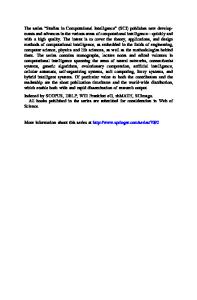Ordered dynamics in biased and cooperative Boolean networks
- PDF / 568,366 Bytes
- 19 Pages / 595.276 x 793.701 pts Page_size
- 58 Downloads / 364 Views
RESEARCH
Open Access
Ordered dynamics in biased and cooperative Boolean networks Winfried Just1* and Germán A Enciso2 * Correspondence: [email protected] 1 Department of Mathematics, Ohio University, Athens, 45701, USA Full list of author information is available at the end of the article
Abstract This paper contributes to the theoretical analysis of the qualitative behavior of two types of Boolean networks: biased and cooperative ones. A Boolean network is biased if at least a specified fraction of its regulatory functions returns one Boolean value more often than the other and is cooperative if there are no negative interactions between the variables. We prove nontrivial upper bounds on the maximum length of periodic orbits in such networks under the assumption that the maximum number of inputs and outputs per node is a fixed constant r. For the case of n-dimensional networks with r = 2 in which only AND and OR are allowed, we find an upper bound of 10n/4 , which is asymptotically optimal in view of previously published counterexamples. The theoretical results are supplemented by simulations of the generic behavior of cooperative networks which indicate that for large indegrees, trajectories tend to converge rapidly towards a steady state or a small periodic orbit. The latter starkly contrasts with the behavior of random arbitrary Boolean networks. MSC: 05A15; 06A07; 34C12; 39A33; 94C10; 92C42 Keywords: Boolean networks; cooperative dynamical systems; biased regulatory functions; chaotic dynamics; Sperner families
1 Introduction Mathematical models of biological problems have become increasingly sophisticated with the advent of new quantitative techniques. Models involving dozens of proteins at the cell level abound in the literature [, ], mostly created using continuous methods. An interesting counterpart to continuous systems are Boolean networks, characterized by discrete time dynamics and the existence of only two possible states ( and ) for each variable at any given time []. In the face of parameter uncertainty, modeling using Boolean networks can produce qualitative predictions at the right level of detail for many applications. This paper continues a line of theoretical research exploring the qualitative behavior of so-called cooperative Boolean networks. This concept corresponds to systems that have exclusively positive interactions among their variables, and in particular are monotone, which means that they have only positive feedback loops. Such networks have been proposed as important tools for gaining insight into the dynamics of gene regulatory and other biological networks []. In the case of systems with at most two inputs for each variable, a cooperative Boolean network can only have constant, AND, OR and COPY regulatory functions. The continuous counterpart of this definition has been studied extensively [], and under mild conditions the generic trajectory of a continuous cooperative system is guaranteed to converge towards the set of equilibria. ©2013 Just and Enciso; licensee Springer. Th
Data Loading...











